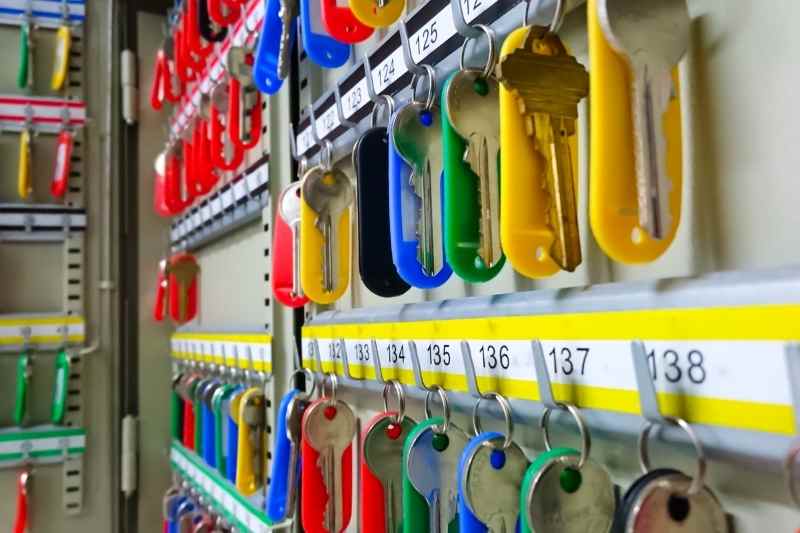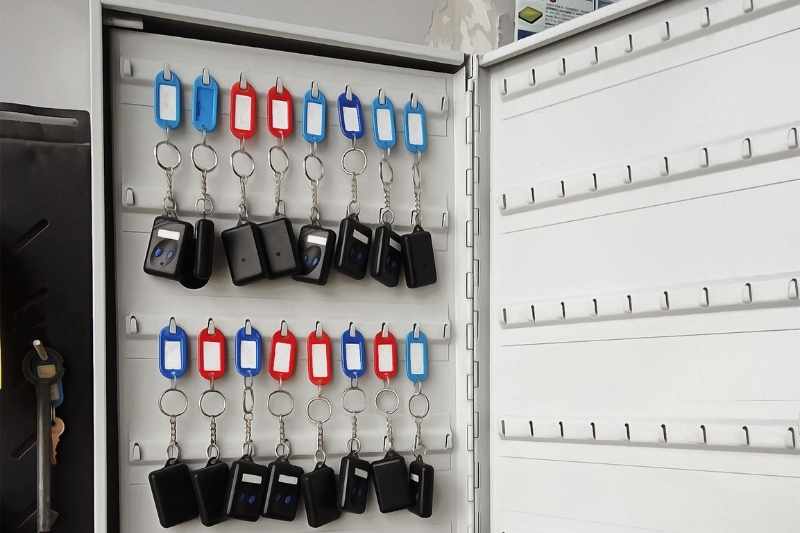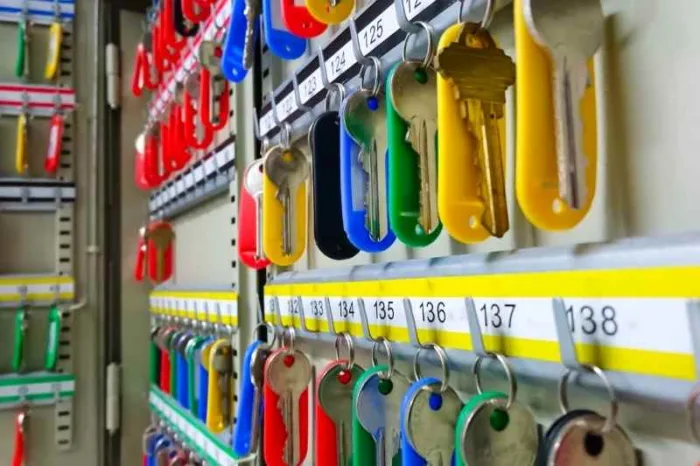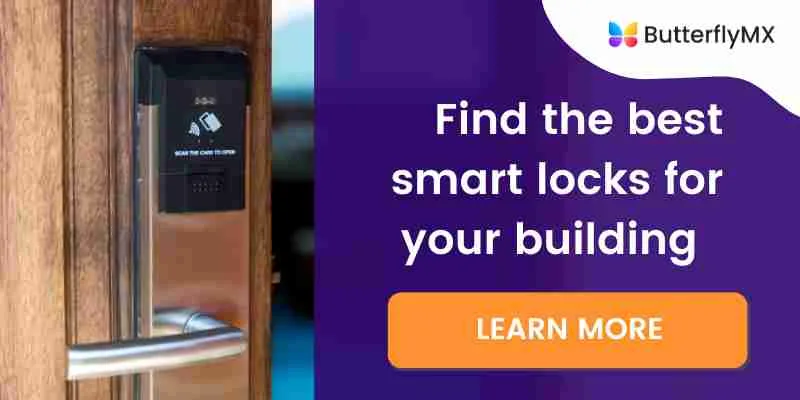Key takeaways
- A key cabinet is a storage solution designed to help organize and maintain a property’s metal keys.
- You should use key storage cabinet to enable self-guided touring, easily share keys with others, and grant access to service providers when staff are not available.
- Key storage cabinets should be organized by using key tags or labels, creating a detailed identification document, storing extra keys in a safe place, and eliminating traditional keys where you can.
- Before purchasing a key storage cabinet, consider the access method you want, the size you need, and where you want it installed.

Whether you own or manage a property, your responsibilities are plentiful — and that includes managing keys by storing them in a key cabinet.
Key management is the process of effectively storing and organizing physical keys. These include apartment unit keys, front entrance keys, and even mail keys that are critical to a building’s function. Your job is to make sure they aren’t lost or stolen, whether you use a key cabinet, key locker, or safe.
Read on to learn more about key control cabinets, including why you should use them, how to organize keys, and how to choose a storage solution. Most importantly, you’ll discover what the best key cabinets are and a better alternative.
Keep reading to discover:
- What is a key cabinet?
- Why use a key organizer cabinet?
- How to organize a key cabinet
- How to choose a key storage cabinet
- 5 Best key cabinets for storing and organizing keys
- What is a better alternative to key cabinets?
What is a key cabinet?
A key cabinet is a key storage solution that keeps physical keys safe and organized. With a key organizer, keys are centrally located — making them easy to monitor, find, and use.
Most key storage cabinets have a door and many have a lock. For maximum security, choose a cabinet with a lock. This could be a traditional keyhole lock or a combination lock with a numeric passcode.
Usually, key cabinets are stored in a lobby or near the front desk. You can place your cabinet on the floor or a table, or opt for a wall-mounted key lock box.
Traditional key organizers aren’t electrically powered, requiring manual operation. However, there are some electronic key storage cabinets.
What is an emergency key cabinet?
Emergency key cabinets — also known as break glass key boxes or Knox Boxes — are key storage solutions used to secure a key in the event of an emergency, such as a fire.
The keys located inside go to locked doors, fire exits, or emergency equipment. In the event of an emergency situation, emergency services will open the box to retrieve keys and access the necessary area.
Emergency key boxes are typically brightly colored red and are labeled with clear signage. As for the access method, these boxes may have a pane of glass that needs breaking, or the emergency services will have their own key to open the box.

Why use a key organizer cabinet?
It’s no secret that managing property comes with big responsibilities. A lot of those will include the use of keys. Whether it’s for an apartment or an office, both residential and commercial key cabinets help property staff share keys and maintain security. Depending on the number of units in your building, there could be hundreds of keys to manage, including spares.
Some cases in which you’ll need to use a key cabinet:
- Self-guided tours. Enable prospects to tour your property on their own with a code-enabled key cabinet. Provide them with the access code so they can get the key and drop it off after touring the unit. In turn, you won’t need a staff member, and you can draw in more prospects with a convenient feature.
- Storing shared keys. Share keys with your property staff or other personnel who may need access when you’re not around. A storage cabinet is a safe place to keep keys until the personnel can retrieve them.
- Guest key retrieval. Grant access to guests — like friends and family — who require spare keys to access a resident’s unit. If you’ve strategically placed a cabinet, you can keep keys in it for these limited instances.
- Service provider access. Give service providers, like plumbers, IT, or electrical companies, access to rooms within the building without needing a staff member posted during their arrival.
How to organize a key cabinet
You probably have a key for every access point throughout your building — which means you have a lot of keys! And without a proper storage system, they’re easy to misplace.
You can organize your property management keys by:
- Using key tags. Label your keys with tags that clearly identify what the key accesses. This way, anyone using the key knows where it goes.
- Creating a key ID document. Establish a clear document identifying your keys. While key labels are helpful, there is only so much room to write on them. Therefore, you should create a document that clearly outlines all of your keys’ details, such as where they go, how many copies, and who has access. Above all, share the document with other essential personnel so they can view it whenever they need it.
- Storing extra keys elsewhere. Use a key safe or lock box stored away from prying eyes to ensure additional keys are not lost. Plus, you want to clearly label them so you know which keys go where. So, if you ever need an additional key or a replacement, you have additional stored away for the future.
- Going keyless: Eliminate the need to organize metal keys altogether by installing smart locks, access control, and other keyless security solutions. By enabling smartphones or biometrics as credentials, you won’t have to spend time tracking and organizing keys. Instead, you can manage user access through an online dashboard or mobile app.
Learn more about self-guided tours:
How to choose a key storage cabinet
Before buying any product for key management, it’s important to determine what features benefit you the most. However, you’ll need to know your needs before making a selection.
Here are some factors to consider when choosing the best key cabinet lock boxes:
- Access method. Determine how you want to secure your key organizer, if at all. Some key storage cabinets are always unlocked, while others require credentials. Overall, access methods range from combinations and PIN codes to metal keys and smartphones.
- Different sizes. Choose a cabinet that can hold the number of keys you have. Cabinets can vary from holding just a handful of keys to hundreds. Fortunately, there are a lot of key storage cabinet sizes to choose from.
- Placement. Install your cabinet for keys on a wall, door, piece of furniture, or, if large enough, free-standing. Regardless of how you place your cabinet, it should be secured to a surface so it can’t be moved and in a location that isn’t entirely public.
5 Best key cabinets for storing and organizing keys
Key cabinets vary in features, design, and security, making it difficult to determine which is right for your key management needs.
So, here are the five best key cabinets for storing and organizing keys:
- BARSKA 100 Digital Key Cabinet
- Honeywell 40 Slot Key Box
- SentrySafe Key Box
- Kidde Key Cabinet Pro
- UMEKEN Wall-Mounted Key Box
1. BARSKA 100 Digital Key Cabinet
The BARSKA 100 Digital Key Cabinet is a premium key storage solution that offers a variety of helpful features for any type of property. Its 100 key capacity makes it a robust solution for large properties. Additionally, installing this high-capacity key storage system on the wall is simple with the included hardware and pre-drilled holes.
What’s more, a unique feature of the BARSKA key storage cabinet is a drop slot. With the drop slot, staff members or visitors can return keys without accessing the rest of the cabinet. As a result, you can have peace of mind when lending out keys.
Pros:
- High-capacity
- Mountable on the wall
- Batteries and hardware included
- Included key tags
- Drop slot
- Digital keypad and key entry methods
Cons:
- Most expensive option on this list
Pricing: The BARSKA Digital Key Cabinet is $259.99
2. Honeywell 40 Slot Key Box
Honeywell is known for its vast range of products, including the 40-slot combination key cabinet. Store up to 40 keys in this cabinet, featuring a combination lock as an access method. The combination lock features only three dials, giving you limited options when it comes to creating a code. However, key tags and mounting hardware are included.
Pros:
Combination lock
Included key tags and mounting hardware
Affordable
Cons:
- Small capacity
- Limited digits for combination lock
Pricing: You can find the Honeywall 40 Slot Key Box for $49.95.
3. SentrySafe Key Box
SentrySafe’s Key Box is a 50-capacity key storage solution made of durable steel. To ensure your keys are organized, 50 key labels are included. Unlike previously mentioned solutions, SentrySafe’s key box exclusively uses a key to gain access to contents. Nonetheless, the compact size and included mounting hardware make this key box a simple solution for your key storage needs.
Pros:
- Affordable
- Compact design
- Steel casing
- Included mounting hardware
- 50 key tags included
Cons:
- Small capacity
Pricing: SentrySafe’s key box is listed for $39.99.
4. Kidde Key Cabinet Pro
The Kidde Key Cabinet Pro provides ample key space while maintaining a convenient and secure storage solution. Unlike other options on this list, Kidde’s key storage solution is available in three different sizes based on the number of keys it stores: 30, 60, and 120.
Furthermore, Kidde’s key cabinet features a customizable keypad with more than 1000 different combinations. Of course, a key entry option is also available. Meanwhile, the clutch mechanism reduces the chances of forced entry, further protecting your keys.
Pros:
- Keypad and key entry options
- Size options
- Multiple combinations with keypad
- Clutch mechanism to reduce forced entry
- Limited numbered of key tags included
Cons:
- Susceptible to break-ins despite clutch mechanism
- Key tags included may not be exhaustive
Pricing: The 30, 60, and 120-key cabinets from Kidde are available for $69.99, $85.88, and $110.35, respectively.
5. UMEKEN Wall-Mounted Key Box
Similarly to Kidde, UMEKEN offers its wall-mounted key box in multiple sizes ranging from 64 keys to 200 keys. Thus, you’re able to select a key storage cabinet that best fits your property size.
The cabinet is secured using a key which UMEKEN includes four copies of alongside a number of colored tags based on the size. Plus, pre-drilled mounting holes and included hardware make installation easy. Not to mention, the UMEKEN key organizer can fit almost anywhere with its durable heavy-gauge steel casing.
Pros:
- Multiple cabinet sizes
- Key tags included
- Mounting hardware included
- Steel casing
Cons:
- Strictly key access
Pricing: The UMEKEN Wall-Mounted Key Box is available in 64, 100, 160, and 200-key sizes at $69.99, $109.99, $124,99, and $149.99, respectively.
What is a better alternative to key cabinets?
Upgrade your property’s security by replacing traditional metal keys with smart locks that integrate with a comprehensive access control system, such as ButterflyMX.
As a leading cloud-based access control provider, ButterflyMX is trusted in over 20,000 buildings and has received more than 50,000 five-star reviews. Our platform connects seamlessly with smart locks, enabling you to move away from physical keys and embrace mobile-based access.
By offering smartphone access to staff, tenants, guests, and service providers, ButterflyMX streamlines entry into all areas of your property. Our system is designed for full-property integration, allowing you to manage access from main entrances and gates to elevators, shared spaces, and even individual apartments.
This eliminates the need to juggle physical keys, simplifying access control.






